Table of Contents
Why is Cordyceps sinensis referred to as ‘The Tibetan Treasure’?
Cordyceps sinensis is one of the most popular natural remedies in traditional Asian medicine. As stated in The FAO’s publication Wild Edible Fungi – A Global overview of their use and importance to people, this mushroom is solely “eaten” for its health benefits. It grows naturally on the Tibetan plateau, and for years has been intensively collected in areas of China, Bhutan and Nepal. Its medicinal properties and the significant financial benefits it brings to those who collect it, make it a very valuable resource.
Cordyceps sinensis is worth more than its weight in gold
Last December, an article in The Economist referred to the value of Cordyceps as a medicine, “often so high that it is worth more than its weight in gold”.
In 2008, a report in the Los Angeles Times quoted a Tibetan nomad who claimed that he earned as much as a thousand dollars a week collecting this mushroom. Other research papers state that a single mushroom may cost two euros in a local market, and may be worth forty times more in specialised markets.
The result of a fascinating biological process
In Asia, this mushroom is popularly known as ‘winter insect, summer grass’, a referring to it’s development and fruiting.
In summer, the spores of this mushroom invade the caterpillars of several species of moths that are commonly found in the pastures on the plains of the Himalayas, at over 3,800 metres above sea level. During the winter, the larvae carriers of the mushroom bury themselves in the soil to hibernate, while the mycelium of mushroom invades their bodies.
When spring arrives, the mycelium is reactivated as the fruiting process starts by producing a long, cylindrical body that grows up through the pastures to reach the sunlight. A single Cordyceps sinensis may be as much as 4 cm long and 300-500 mg in weight. Once collected, this organism has two well-differentiated parts – one of which is brown (the stroma), the other being an orangey colour (the caterpillar’s mummified body).

They are all Cordyceps sinensis
Although its scientific name is Cordyceps sinensis, these are the best-known names for this mushroom:
- Yasra gumba, Yarcha gumba (local names)
- Jeera jhar, Jeevan buti, Keeda ghass, Chyou kira, Sanjeevani bhooti (names common in Nepal)
- Dong Chong xi cao (name common in China)
- Tocheikasa (name common in Japan)
The role of the yak in the history of Cordyceps
The energy-giving properties of this fungus are related to grazing in Tibet. According to tradition, when spring arrived and the snow started to melt, the herders took their cattle up to the high parts of the mountains to eat the fresh grass. Here, the cattle also ate what was considered to be a ‘brown grass’, which was later identified as Cordyceps sinensis. The herders noticed that, after eating it, their yaks, goats and sheep were stronger and more robust, and even behaved as though they were on heat. The first medicinal uses of Cordyceps were related to improving cattle’s vitality and ability to reproduce.
The first mentions of the medicinal properties of Cordyceps
A total of 100 species of Cordyceps, are known, but Cordyceps sinensis is one of the most highly valued, with most uses in traditional medicine.
The first references to it as a medicinal mushroom appeared during the Qing dynasty in China in the treatise Ben-Cao-Cong-Xin (New Compilation of Materia Medica) in the eighteenth century. In the West, the first reference to this mushroom was by the Du Halde, a French Jesuit historian, who personally experienced its invigorating effects.

Uses of Cordyceps in traditional Tibetan medicine
The healers who practised traditional medicine used it to treat twenty-one diseases. Cordyceps sinensis was used for all illnesses as a “tonic” that could improve energy, appetite, strength, libido, and sleep.
Over 2,000 scientific articles
Over 2,000 scientific articles have been written about Cordyceps sinensis since the 80s. Many of these have determined the effects of this species – on the kidney, liver, genito-urinary and immune systems, for energy and respiratory function.
Unique chemical compounds
In 1993, Cordyceps received attention after the results of certain Chinese athletes in a national competition. They broke world records in the 1,500, 3,000 and 10,000-metre races without showing any symptoms of fatigue. These results were partly due to a special diet that included Cordyceps sinensis.
Several scientific studies have confirmed that it increases the use of oxygen and the production of ATP, increasing muscular power, reducing muscle recovery time and speeding up the removal of lactic acid.
Cordyceps and sports performance
One of the main reasons for this mushroom’s medicinal value is the fact that it contains unique chemical compounds, of which the most important are:
- Cordycepic Acid
- Galactomannan
- Mannitol
- Ergosterol (precursor of vitamin D)
- Adenosine
- Cordycepin
- Essential amino acids
- Vitamins (B1, B2, B12, E and K)
- Minerals (Na, K, Ca, Mg, Fe, Cu, Mn, Zn, Se, Al, Si and Ni)
We recommend

Linoleic Acid: Why This Essential Omega-6 Is Vital for Your Health
☑️ Linoleic acid is a polyunsaturated omega-6 fatty acid essential for human health, as the body cannot synthesise it and must obtain it through diet. This fatty acid plays several critical roles, including supporting skin integrity, contributing to the formation of cell membranes, and serving as a precursor to important bioactive compounds. Its anti-inflammatory properties and role in maintaining the skin barrier make it particularly beneficial for skin health. Understanding the importance of linoleic acid and ensuring adequate intake can significantly impact overall well-being.

Are all red mushrooms toxic?
Red mushrooms are often perceived as toxic, but sometimes other properties are also recognised. Let’s discover them together in this post.
